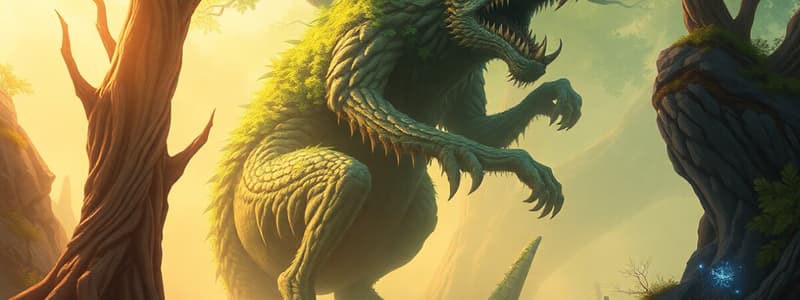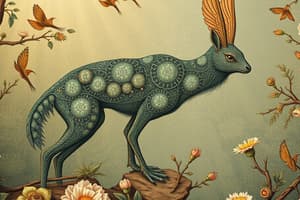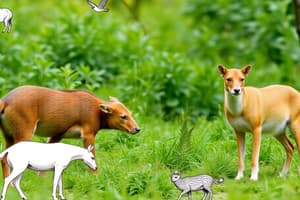Podcast
Questions and Answers
Flashcards
Adaptation
Adaptation
The ability of an organism to live successfully in its environment.
Xerophyte Adaptation
Xerophyte Adaptation
The ability of xerophytes to store sugar and minerals in vacuoles.
Cryptic Colouration
Cryptic Colouration
A color pattern that helps an organism blend into its environment.
Competition
Competition
Signup and view all the flashcards
Genotypes of Parents
Genotypes of Parents
Signup and view all the flashcards
Tongue Rolling
Tongue Rolling
Signup and view all the flashcards
First Evolution Scientist
First Evolution Scientist
Signup and view all the flashcards
Aquatic Plant Structure
Aquatic Plant Structure
Signup and view all the flashcards
Blood Type Universal Recipient
Blood Type Universal Recipient
Signup and view all the flashcards
Inbreeding Encouragement
Inbreeding Encouragement
Signup and view all the flashcards
Energy in an Ecosystem
Energy in an Ecosystem
Signup and view all the flashcards
Stable Ecosystem Influence
Stable Ecosystem Influence
Signup and view all the flashcards
Honey Bee Role
Honey Bee Role
Signup and view all the flashcards
Plant Distribution Factor
Plant Distribution Factor
Signup and view all the flashcards
Dominant & Recessive Traits
Dominant & Recessive Traits
Signup and view all the flashcards
Baby's Sex Determination
Baby's Sex Determination
Signup and view all the flashcards
Niche
Niche
Signup and view all the flashcards
Freshwater Pond Organisms
Freshwater Pond Organisms
Signup and view all the flashcards
Hygrometer Function
Hygrometer Function
Signup and view all the flashcards
Salt and Water Transport in Plants
Salt and Water Transport in Plants
Signup and view all the flashcards
Imperata spp Occurrence
Imperata spp Occurrence
Signup and view all the flashcards
Carbon Dioxide Sources
Carbon Dioxide Sources
Signup and view all the flashcards
Food Shortages Causes
Food Shortages Causes
Signup and view all the flashcards
Epiphytic Habitat
Epiphytic Habitat
Signup and view all the flashcards
Hearing Parts
Hearing Parts
Signup and view all the flashcards
Seedling Growth in Dark
Seedling Growth in Dark
Signup and view all the flashcards
Invertase Function
Invertase Function
Signup and view all the flashcards
Gas in Respiration
Gas in Respiration
Signup and view all the flashcards
Advanced Plant Group
Advanced Plant Group
Signup and view all the flashcards
Monocot Characteristics
Monocot Characteristics
Signup and view all the flashcards
Crustacea Group
Crustacea Group
Signup and view all the flashcards
Mode of Feeding in Amoeba
Mode of Feeding in Amoeba
Signup and view all the flashcards
Free-Living Cells
Free-Living Cells
Signup and view all the flashcards
Symbiosis
Symbiosis
Signup and view all the flashcards
Amphibian Habitat
Amphibian Habitat
Signup and view all the flashcards
Study Notes
Biology 2001
- The ability of an organism to live successfully in an environment is known as adaptation
- A freshwater pond may contain water lily, fish, water scorpion, and dragon larvae
- The ability to roll the tongue is a variation
- The role of the male adult honey bee is to care for the young
- The distribution of plants in a rain forest is governed mainly by the amount of sunlight
- The highest percentage of energy in an ecosystem occurs at the level of the producers
- The center for learning and memory in the human brain is the cerebrum
- The parts I, III and IV function together for hearing
Studying That Suits You
Use AI to generate personalized quizzes and flashcards to suit your learning preferences.




